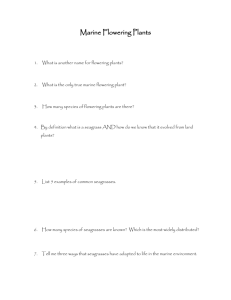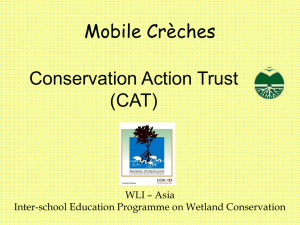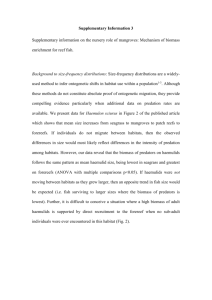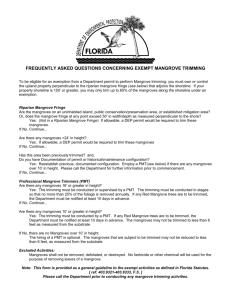Seagrasses & Mangroves
advertisement
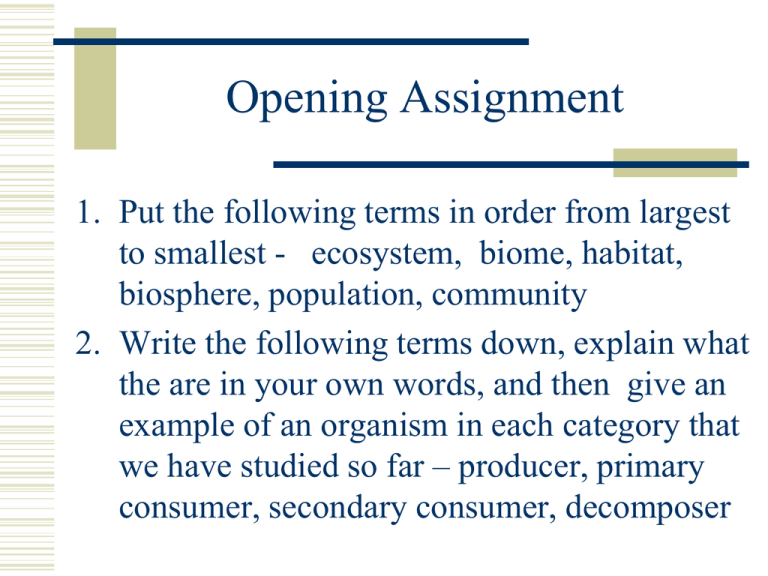
Opening Assignment 1. Put the following terms in order from largest to smallest - ecosystem, biome, habitat, biosphere, population, community 2. Write the following terms down, explain what the are in your own words, and then give an example of an organism in each category that we have studied so far – producer, primary consumer, secondary consumer, decomposer Opening Assignment ANSWERS Put the following terms in order from largest to smallest - ecosystem, biome, habitat, biosphere Answer: Biosphere, biome, ecosystem, habitat, community, population Opening Assignment ANSWERS Producer – an organism that can make it’s own food – like photosynthetic algae (Kingdom Protista) Primary consumer – an organism that eats producers – like sponges who filter algae from the water Secondary consumer – an organism that eats primary producers – like an octopus eating a mussel Decomposer – an organism that breaks down dead organisms – like chemosynthetic bacteria Seagrass Food Web Activity Use the chromebooks or your phone to research a Seagrass Food Web. Draw a picture of one and label the producers, primary consumer, secondary consumer, and decomposers. Opening Assignment Day 2 List 3 reasons why plants are so important in an ecosystem. Unit 7: Seagrasses and Mangroves Learning Goals Students will be able to Explain the structure, function, and importance of seagrasses and mangroves in ecosystems. Describe how humans can positively and negatively effect seagrass and mangrove communities. Part 1: Seagrasses Overview Seagrass Definition Distribution Diversity Importance Human Impacts Conservation Defining Sea grass Marine plants with the same basic structure as terrestrial (land) plants. Have tiny flowers and strap-like or oval leaves. Have separate roots, leaves and stems. Have a network of veins that moves nutrients and dissolved gases around. Form meadows in: estuaries and shallow coastal waters with sandy or muddy bottoms. Seagrass Anatomy Blade Main photosynthetic organ. Short Shoot Stem. Rhizome Horizontal stems and root like structure that connects adjacent short shoots together and anchors the plant to the substrate. Movement of waste and nutrients. Extension and reproduction of clones. Root Anchor plant. Absorb nutrients and excrete waste. Copy and label this diagram Distribution of Seagrasses Globally Distribution of Seagrasses Locally Distribution is site specific Depends on location. Zonation Seagrasses are limited by Salinity Species specific Water level Dry out if exposed. Light availability Need light photosynthesize Diversity of Seagrasses Globally ~50 species Locally in the Indian River Lagoon 7 species of seagrass Shoal Grass Halodule wrightii Most common. Manatee Grass Syringodium filiforme Most common. Turtle Grass Thalassia testudinum Paddle Grass Halophila decipiens Johnson Grass Halophila johnsonii Endangered species. Star Grass Halophila engelmannii Widgeon Grass Ruppia martima Found in low salinities. Seagrass Species in the IRL Turtle Grass Johnson Grass Star Grass Widgeon Grass Shoal Grass Manatee Grass Paddle Grass Importance of Seagrass Habitat for many organisms Provides food and shelter Nursery ground (place for young animals to grow up) Importance of Seagrass Produce oxygen Importance of Seagrass Reduce wave energy in fragile environments. Trap sediments to stabilize the ocean floor. Human Impacts on Seagrass In 1950, it was estimated that Florida had over 5 million acres of seagrass. Today, approximately 2 million acres exist.3 Worsening water quality Pollution. Reduced light. Extreme salinity changes. Freshwater input from flood gates. Coastal development Loss of tidal marshes. Mechanical damage Dredging and filling. Scarring by boat propellers. Commercial shellfish industry Handley, L., Altsman, D., and DeMay, R., eds., 2007, Seagrass Status and Trends in the Northern Gulf of Mexico: 1940–2002: U.S. Geological Survey Scientific Investigations Report 2006–5287, 267 p. Seagrass Conservation Federal Laws protecting Seagrass Endangered Species Act Limitations on dredging Boating Restriction Zones No entry zones Brevard County No combustion engine zones Seagrass Research Conduct surveys Assess changes/conditions Aquaculture Transplantation Public Education Seagrass Conservation: What you can do Water Quality: Following directions on lawn and garden products. Do not over-use fertilizers, pesticides, or herbicides. Construction Practices: Rainfall can erode bare earth. The sediment is carried to the bay where it may cloud the water or cover seagrasses - reducing photosynthesis. Properly placed and maintained sediment fences will capture the sediment before it reaches the water. Boating: Know the water depth requirements of your boat's design. If you observe seagrass in the propwash, you are too shallow! Stop the motor and drift or pole into deeper water. Dredging Activities: Stay informed about dredging activities in your area and support measures to protect seagrass during these operations. Opening Assignment Day 2 1. Explain 3 things that limit where seagrass lives. 2. List 3 things that humans are doing that negatively affect seagrass. 3. What are 3 things that you can do to conserve seagrasses. Day 2 Activities Work on the Seagrass packet and turn in when completed. Then Seagrasses and Mangroves Part 1 – http://www.bing.com/videos/search?q=seagr asses+and+mangroves+part+1&FORM=VIR E1#view=detail&mid=C1CCE77BA1F8F35 B51B0C1CCE77BA1F8F35B51B0 Opening Assignment Day 3 1. Copy the diagram of a seagrass and label it. 1. 2. 3. 4. More Review: Match the term with the correct function. Write the function out (it will help you remember it ) 1. 2. 3. 4. A. Moves wastes and Blade _______ nutrients to extensions of main plant (asexual Short Shoot reprod.) ______ Rhizome ________ B. Anchors plant and absorbs nutrients like nitrogen, Root __________ carbon, and water C. Main photosynthetic organ of plant D. The stem Day 3 Activities Notes on how Seagrasses are mapped and monitored. Then practice together calculating seagrass populations. Then Seagrasses and Mangroves part 2 Quadrat sampling in science Is used to monitor changes in seagrass beds over time Scientists monitor set locations (sites) using transects of multiple quadrats Results can be used to produce maps of seagrass meadows Quadrat Monitoring Seagrass Mapping Allows scientists to look at changes in size and composition (what species are present) of seagrass meadows. Example of a stacked bar graph Always put each species in the same place Allows comparisons of both total amount of something and the composition of the total Seagrass Mapping Results Seagrasses and Mangroves Part 2 https://www.youtube.com/watch?v=jUwX_2 pDqa8 Opening Assignment Explain why scientists monitor the distribution of seagrasses. Quadrat Monitoring Opening Assignment Day 4 Please answer these questions based on the seagrass mapping worksheet. 1. In what year is the seagrass meadow composed of only one type of seagrass? 2. Which year has the largest seagrass meadow? 3. Which species of seagrass experience(s) a decline in abundance from 1998 to 1999? Opening Assignment In a 10 X 10 quadrat, what percentage does each square represent? What can scientists use a quadrat to monitor? Opening Assignment – Day 4 In a 10 X 10 quadrat, what percentage does each square represent? What can scientists use a quadrat to monitor? Opening Assignment Day 4: Quadrats at Work Lab Get ready to go outside to do “seagrass” research with quadrats. EACH student needs something to write with and something hard to write on (notebook?) Each group needs a calculator (a phone can be used but if you are on any social media during the activity you will receive a zero on the assignment.) Quadrats at Work Lab Work in groups of 3 or 4 Each person counts the quadrat INDEPENDENTLY A square of the quadrat can be Empty = 0 Half covered = .5 Fully covered = 1 Once all group members have calculated the percent coverage the group will take the mean of the quadrat Opening Assignment Day 5 On a blank piece of paper, please tell me (in complete sentences): 3 things you learned doing the quadrats at work activity and the mapping and monitoring worksheet. One thing that would improve the activity (either something I could do differently or something you could do differently) Get your quadrat lab worksheet out of the bin so we can review it. Part 2: Mangroves Assignment for today Please get an Oceans book out and read pages 214-215. Copy and answer the following questions. 1. 2. 3. 4. Explain the physical environment that mangroves grow in. Why do they only live in tropical areas? List 3 organisms that live in the mangrove community. How do mangroves help prevent erosion? Day 5 Assignment Answers 1. 2. 3. 4. Explain the physical environment that mangroves grow in. They live in soft, waterlogged, oxygen poor mud with plenty of saltwater. Why do they only live in tropical areas? They cannot tolerate a climate change of more than 18 degrees farenheit. List 3 organisms that live in the mangrove community. Fiddler crabs, crocodiles, mud lobsters, window oyster . . .and MANY more How do mangroves help prevent erosion? Their root systems hold the mud in place to prevent erosion. Defining Mangroves A woody plant or plant community which lives between the sea and the land in areas which are inundated by tides. A species as well as a community. Ability to live in salt water. Occur in sheltered coastline areas in the tropical and subtropical inter-tidal regions. Bays, estuaries, lagoons, and creeks. This is a challenging environment due to low oxygen, high salt levels, and soft sediment. Diversity of Mangroves in IRL Globally: ~65 species Locally in the Indian River Lagoon: 3 species of mangroves Red Mangrove Rhizophora mangle Most recognized. Black Mangrove Avicennia germinans Tolerates colder temperatures. White Mangrove Laguncularia racemosa Furthest up shoreline. Diversity of Mangroves in IRL Red Mangrove Black Mangrove White Mangrove Mangrove Anatomy Trunk Branch Leaf Prop Root Above ground roots that provide mechanical support to the plant. Pneumatophore (a.k.a snorkel roots) A root often functioning as a respiratory organ in a wetland plant. Propagule/Seed The fertilized seed of a mangrove plant containing an embryo and capable of germination to produce a new plant. Propagules Leaf Prop Roots Seed Trunk Pneumatophores Branch Distribution of Mangroves Globally What about local distribution? In the Indian River Lagoon each species of mangrove has its own niche, based on its unique adaptations. One species is located at the waters edge, one slightly inland, and the third highest upland. Distribution of Mangroves Local Zonation Typical pattern from water to land Red Black White Mangroves are limited by: Temperature Salinity Wave energy Soil oxygen levels Drainage Differing nutrient levels Importance of Mangroves Habitat for diversity of organisms Provides food and shelter Leaf litter nutrients 1kg/m2/year Nursery ground Importance of Mangroves Producer of oxygen and filter water Importance of Mangroves Reduce wave energy in fragile environments. Trap sediments to stabilize the shoreline. Human Impacts on Mangroves Mosquito Control Impoundments alter water flow. Since 1950 more than 75% of the marsh and mangrove wetlands bordering the IRL have been destroyed. > 40,000 acres have been turned into mosquito impoundments. Coastal development Residential and commercial. Cut back mangroves Siltation due to bare earth Aquaculture & Agriculture Shrimp farms. Fertilizer and pesticide run-off. Dredging/Industrialization Ports and harbor development. Conservation of Mangroves Environmental Protection Act, 1986 Reconnecting mosquito impoundments to lagoon. Mimic tidal flow Laws restricting mangrove trimming. Mangrove replenishment Plant mangroves in areas suitable for development. Help to cement the roots by pvc housing. Public education Research Conservation of Mangroves: What you can do Water Quality: Following directions on lawn and garden products. Do not over-use fertilizers, pesticides, or herbicides. Do not pollute. Construction Practices: Cutting down mangroves is illegal and can lead to erosion. Report mangrove removal to the proper authorities. Dredging Activities: Stay informed about dredging activities in your area and support measures to protect mangroves during these operations. What are the challenges for mangroves? Copy this chart Low oxygen High salt levels Soft sediment Red Prop roots absorb oxygen through lenticels Salt is excluded by the prop roots Prop roots Black Pneumatophores Excrete salt at the surface of the leaves Not an issue because they are found further from the water White Not an issue because they are found further from the water Salt glands at the base of leaves Not an issue because they are found further from the water Mangroves – Guardians of the Coast https://www.youtube.com/watch?v=4SY7X9 zdZ-U As you are watching this take some notes on why mangrove forest ecosystems are so essential to this Indian village. After the video you will write a summary on this topic. Opening Assignment 1. List 3 reasons why mangroves are important components of marine ecosystems. 2. What are the 3 challenges that mangroves must be adapted to in order to survive? Mangrove Creature Feature Worksheet Finish your creature feature worksheet and be ready to explain what you have created. If it is already completed look over your mangrove and seagrass notes and make up 10 questions and answers to use for our unit review game for Monday. Unit quiz will be on Tuesday Opening Assignment How are prop roots and pneumatophores similar and different? How are the three types of mangroves situated from the land out to the water? Opening Assignment Due at 2:08 1. Where do Mangroves live? 2. Where do seagrasses live? 1. 3. Without looking at your notes identify the numbered items. 2. 3. 4. Mangroves video https://www.youtube.com/watch?v=9SMM7 x7qKE4 Unit 8: Seagrasses and Mangroves Review Game Get into groups of 2-3 Grab a dry erase board and a marker Question #1 List the 3 types of mangroves that live in the Indian River Lagoon and where they live in relation to the water. Question #2 Which type of mangrove lives closest to the water? Question #3 What is the name of the root that functions as a respiratory organ for Black mangroves? Question #4 List one adaptation that mangroves have that enables them to survive the high salinity level of the water. Question #5 The fertilized seed of a mangrove plant that contains an embryo and is capable of germination to produce a new plant is called a _______________________. Question #6 Which type of mangrove has more of the prop roots due to where it lives in relation to the water Question #7 The horizontal stem on a seagrass that is responsible for transporting nutrients across to seagrass extensions is called _______________. Question #8 Which type of marine flowering plant can live completely submerged? Question #9 List 3 organisms that live in the Mangrove communities. Question #10 Explain what type of marine flowering plant(s) helps to prevent erosion and how they do this. Question #11 What 3 things limit where seagrasses can grow? Question #12 True or False Cutting down Mangroves is not illegal in Indian River County. Question #13 What 3 things are challenges that Mangroves must be able to adapt to in their environment? Question #14 What are the closest relatives of seagrasses? Hint: it helps provide evidence that they evolved from land plants. Question #15 How do seagrasses reproduce sexually? Opening Assignment Study for your quiz today on Seagrasses and Mangroves There are 5 multiple choice and 10 short answer so review the notes for Seagrasses and Mangroves and also the Marine Flowering Plants questions. Question #1 DNA is made of series of nucleotides. What are the 3 components of a nucleotide? Question #2 DNA is made of series of nucleotides. What are the 3 components of a nucleotide?

